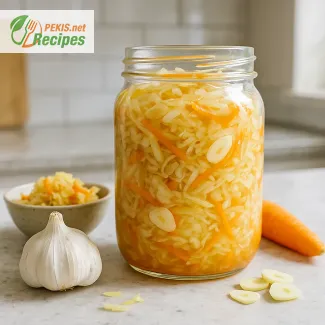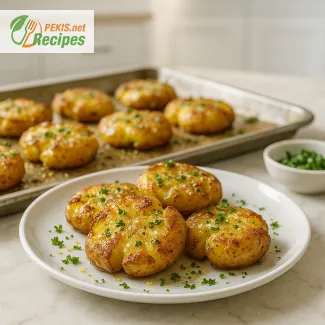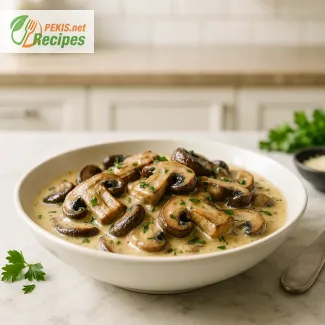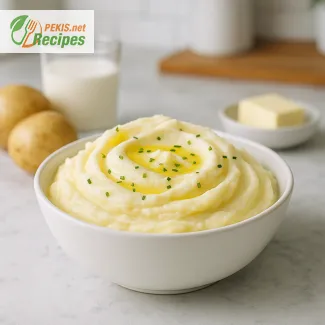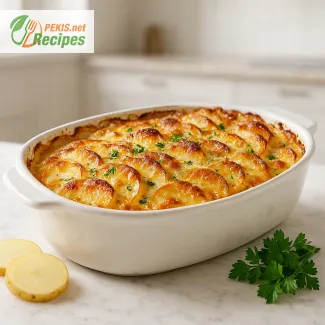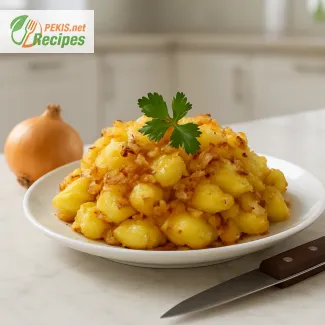Castañas cocidas make a cozy seasonal treat for 4 servings, ready in just 10 minutes prep and 25 minutes cook time. Fresh chestnuts are simmered with a touch of salt and bay leaf until tender and buttery, ideal for serving warm with honey or butter. Naturally gluten-free and nutrient-rich, they offer a soft, creamy texture perfect for sweet or savory dishes. Store peeled chestnuts in an airtight container for up to 3 days in the fridge or 3 months in the freezer for quick use in purées, soups, or desserts.
Cooking boiled chestnuts has always felt like capturing the essence of autumn in a pot — that moment when the sweet, earthy aroma fills the kitchen and the shells begin to split just right. There’s a small ritual in scoring, boiling, and peeling them while they’re still warm; a rhythm that connects to generations before. The key is patience — giving chestnuts the time they need to turn tender and silky, with that naturally sweet flavor that pairs beautifully with butter or honey.
PEKIS – professional chef and recipe developer with more than 25 years of experience in cooking and baking, specialized in European and international cuisine.
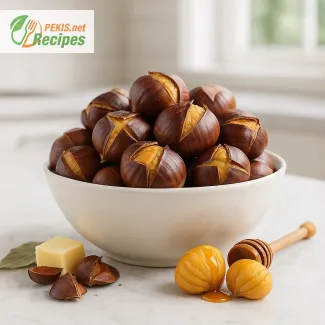
Perfectly tender boiled chestnuts full of autumn flavor
The comforting warmth of cooked chestnuts and how to enjoy them at their best
The moment chestnuts begin to simmer in hot water, a gentle, nutty aroma fills the kitchen—soft, sweet, and slightly earthy. This comforting scent has followed generations across Europe, especially in Spain, Italy, and France, where boiled chestnuts (castañas cocidas) have been a traditional autumn treat for centuries. Their creamy texture and mild sweetness make them a perfect base for both savory and sweet creations—from simple warm snacks to fillings, soups, or even desserts.
Boiling chestnuts is one of the oldest and most accessible ways to prepare them. The process enhances their natural sweetness while keeping the nuts moist and tender. When cooked correctly, the inner flesh becomes soft and delicate, almost melting on the tongue. Unlike roasting, which intensifies their nutty aroma, boiling allows the chestnut to retain its subtle, buttery flavor—ideal for purées or pairing with cream, chocolate, or herbs.
The origin and culinary tradition of boiled chestnuts
For centuries, chestnuts were known as “the bread of the poor”, especially in rural mountain regions where wheat was scarce. In northern Spain and southern France, they were boiled daily and served with milk or honey as a filling and nourishing meal. Over time, chestnuts evolved from a humble ingredient into a seasonal delicacy, celebrated at local fairs and autumn festivals. In Spain, “magostos” mark the arrival of the chestnut season—families gather around fires or steaming pots, enjoying their sweetness under the crisp November air.
The texture, aroma, and perfect timing
Achieving perfectly boiled chestnuts is all about timing. They should be soft enough to mash easily but not so overcooked that they fall apart. The outer shell and thin inner skin should peel off without resistance once slightly cooled. High-quality chestnuts are essential—they should feel heavy for their size and free of cracks or mold. A few simple incisions before boiling prevent them from bursting and make peeling effortless.
When boiled correctly, their velvety texture opens possibilities: you can blend them into creamy soups, fold them into cakes, or mix with butter for a rustic purée. The mild sweetness balances beautifully with salty flavors such as bacon, sage, or rosemary.
Why you’ll love this recipe
- Warm and comforting: the ultimate autumn comfort food for chilly evenings.
- Simple yet elegant: minimal ingredients, maximum flavor.
- Versatile: perfect for snacks, sides, or dessert bases.
- Naturally sweet and healthy: chestnuts offer subtle sweetness without added sugar.
- Traditional and nostalgic: connects modern kitchens with centuries of culinary heritage.
Ingredients that make the difference
Boiled chestnuts rely on just a few basic elements—fresh chestnuts and water—but every detail counts. Adding a pinch of salt to the water subtly enhances the nut’s natural sweetness. Some cooks include a bay leaf or a piece of vanilla pod for an aromatic twist. Once cooked, a touch of melted butter or olive oil can highlight their earthy tones, while a drizzle of honey or maple syrup brings out their dessert potential.
Creative variations
- Sweet version: Serve with warm milk, cinnamon, or a spoon of chestnut honey.
- Savory twist: Toss with herbs, olive oil, and a sprinkle of sea salt.
- Festive flair: Combine with roasted pumpkin cubes for a holiday side dish.
- Modern touch: Blend into a smoothie or use in vegan baking for a nutty base.
Storage and make-ahead tips
Boiled chestnuts can be prepared in advance and stored for up to 3 days in the refrigerator in an airtight container. To reheat, simply steam or warm them gently in a skillet with a splash of water. They can also be frozen for up to 3 months—peel them first and store in freezer bags. When thawed, they retain most of their creamy texture, perfect for quick desserts or purées.
Explore more comforting chestnut recipes
If you enjoy the delicate flavor of boiled chestnuts, discover these comforting variations available in other languages:
- Chestnut purée – silky no bake dessert ready in 20 minutes
- Roasted Chestnut with Rosemary – A classic winter snack with a hint of fresh herbs
Semantic insight: chestnuts as an autumn culinary symbol
Chestnuts represent comfort, warmth, and nostalgia—an ingredient tied deeply to seasonal traditions. In modern cuisine, they bridge the gap between rustic authenticity and refined flavor. Whether used in Mediterranean soups, French desserts, or Spanish holiday spreads, their versatility continues to inspire chefs worldwide. The charm of boiled chestnuts lies in their simplicity: a few natural ingredients, a touch of care, and the unmistakable taste of autumn in every bite.
- Gently rinse the fresh chestnuts under cold water, discarding any that float or show cracks.
- With a small sharp knife, score a shallow cross on the flat side of each chestnut—this prevents bursting and makes peeling easier.
- In a medium pot, pour 1.5 liters of water and add salt and the bay leaf for extra aroma. Bring to a boil.
- Add the chestnuts to the boiling water. Cook uncovered for 25 minutes, or until the nuts feel tender when pierced with a knife.
- Once cooked, drain immediately and cover with a clean kitchen towel for 5 minutes to loosen the skins.
- Peel while still warm—first remove the outer shell, then the thin inner skin.
- Serve warm with a small knob of butter or drizzle of honey, depending on whether you prefer a savory or sweet version.
FAQ questionHow do you know when boiled chestnuts are done?
Boiled chestnuts are ready when the flesh is soft all the way through and a small knife slides in without resistance. This usually happens after 20–25 minutes of gentle boiling, depending on the size and freshness of the chestnuts. If they still feel firm or grainy in the center, keep cooking for a few more minutes. Always test one chestnut first before turning off the heat to avoid undercooking the whole batch.
FAQ questionDo you have to cut chestnuts before boiling?
Yes, chestnuts should always be scored or cross-cut on the flat side before boiling. This prevents them from bursting in hot water and makes peeling much easier afterward. A shallow cross is enough — don’t cut too deep into the flesh. Boiling them uncut often results in tough-to-remove skins and sometimes waterlogged nuts.
FAQ questionWhy are my boiled chestnuts hard to peel?
Chestnuts become difficult to peel if they cool down too much before peeling or if they are old/dried-out chestnuts. Peel them while they are still warm and steamy, ideally right after draining. Covering them with a clean kitchen towel for 5 minutes helps loosen the inner skin. Using fresh, heavy chestnuts also makes peeling much easier because the skins separate better from moist flesh.
FAQ questionCan boiled chestnuts be stored?
Yes, peeled boiled chestnuts can be stored in an airtight container in the refrigerator for up to 3 days. For longer storage, freeze them (peeled) for up to 3 months. When reheating, warm them gently with a splash of water or a bit of butter so they don’t dry out. This makes them perfect for quick purées, soups, stuffings, or desserts.
FAQ questionWhat can you serve boiled chestnuts with?
Boiled chestnuts pair beautifully with roasted meats, game, poultry, autumn vegetables, mushrooms, pumpkin, and leeks. On the sweet side, they go well with honey, vanilla, whipped cream, chocolate, and rum aromas. Because their taste is naturally mild and slightly sweet, they work in both savory side dishes and dessert preparations like chestnut purée.
FAQ questionAre boiled chestnuts gluten-free and dairy-free?
Plain boiled chestnuts are naturally gluten-free, dairy-free, and egg-free, which makes them an excellent base for allergy-friendly dishes. They only become non-dairy if you add butter, cream, or milk when serving. For fully plant-based versions, use olive oil, vegan butter, or maple syrup instead — the texture stays smooth and creamy.
FAQ questionCan you use boiled chestnuts for purée or desserts?
Absolutely. Boiled chestnuts are the best starting point for making smooth chestnut purée, mont blanc, chestnut creams, fillings, and festive desserts because boiling gives them a tender, moist texture. Simply blend the peeled chestnuts with a bit of warm milk, cream, or syrup until silky. For a no-bake version, sweeten with honey or sugar and add vanilla for aroma.
Soft, aromatic, and naturally sweet, boiled chestnuts capture the essence of autumn in the simplest form. Their buttery texture and delicate flavor make them a perfect base for both sweet and savory creations, blending tradition with modern comfort. Whether enjoyed warm on a cozy evening or incorporated into an elegant dish, they bring warmth and depth to every bite.
Cooking chestnuts in water unlocks their gentle nuttiness and keeps them moist—an essential difference from roasting, which gives a smokier tone. This subtle balance makes boiled chestnuts ideal for soups, purées, or festive desserts, where smoothness and tenderness matter most. With only a few ingredients, this simple process transforms seasonal nuts into something that feels indulgent yet natural.
Beyond their taste, chestnuts carry a sense of heritage and tradition. For centuries, families have gathered around steaming pots during the colder months, sharing the scent and comfort they bring. Preparing them today connects us with those timeless rituals—moments that remind us of patience, simplicity, and care in the kitchen.
Their natural sweetness and creamy consistency open endless possibilities. They can be mashed into desserts, blended with herbs for savory spreads, or served on their own with a drizzle of honey. Each preparation highlights a different side of the same humble ingredient, celebrating how seasonal cooking turns everyday ingredients into something memorable.
From the first cut to the final taste, Castañas cocidas embody the quiet beauty of slow, intentional cooking—honoring texture, aroma, and authenticity in every serving.
Allergens present in the recipe:
- None – chestnuts are naturally gluten-free and dairy-free unless butter is added.
Tips for allergen substitutions:
- Replace butter with olive oil or vegan margarine for a dairy-free option.
- Skip honey and use maple syrup or agave nectar for a vegan alternative.
- Vitamin C – 24 mg – supports immune function and collagen production.
- Potassium – 470 mg – contributes to normal blood pressure and muscle health.
- Magnesium – 30 mg – helps with nerve and muscle function.
- Iron – 1.3 mg – aids in oxygen transport in the blood.
- Calcium – 27 mg – supports healthy bones and teeth.
- Gallic acid – 0.8 mg – helps protect cells from oxidative stress.
- Ellagic acid – 0.5 mg – known for its anti-inflammatory and anti-aging properties.
- Vitamin E – 0.3 mg – contributes to the protection of cells from free radicals.
